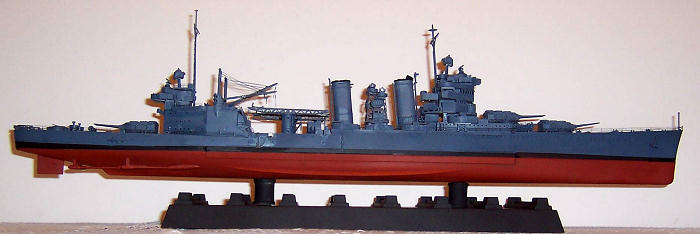
| KIT: | Trumpeter 1/350 USS San Francisco |
| KIT #: | 5309 |
| PRICE: | $75.00 MSRP |
| DECALS: | One option |
| REVIEWER: | Len Roberto |
| NOTES: | Gold Medal Models Photo Etch used. |

| HISTORY |
 San Francisco
San Francisco
| THE KIT |
 This is the first 1/350 scale US WWII cruiser in plastic
that I know of.
Unlike many Trumpeter and Dragon kits of late-
it comes with no photo-etched parts.
I had this on the shelf for months patiently waiting for Loren Perry
of Gold Medal Models, my PE maker of choice, to produce a specific set for this
kit. It
arrived end of May and was all I had hoped for.
This is the first 1/350 scale US WWII cruiser in plastic
that I know of.
Unlike many Trumpeter and Dragon kits of late-
it comes with no photo-etched parts.
I had this on the shelf for months patiently waiting for Loren Perry
of Gold Medal Models, my PE maker of choice, to produce a specific set for this
kit. It
arrived end of May and was all I had hoped for.
The kit is good and typical of Trumpeter ships lately.
Of course some areas are compromised and thatís what PE is for.
I try not to get into the minutiae of whatís accurate or not.
Frankly, I build to relax and appreciate historical machines-
I donít have the drive or time to research and correct everything-
I do what I can!
Anyway, the PE set is superb and addresses the following areas: aircraft catapults, railing, ladders, radars, cranes, and a very nice searchlight platform that looks very nice.
| CONSTRUCTION |
I picked up
a beautiful display case at MosquitoCon in April.
It was $30.00 and I marked it for the
I do not follow Trumpeterís directions.
I build with an eye towards painting which I will try to show below.
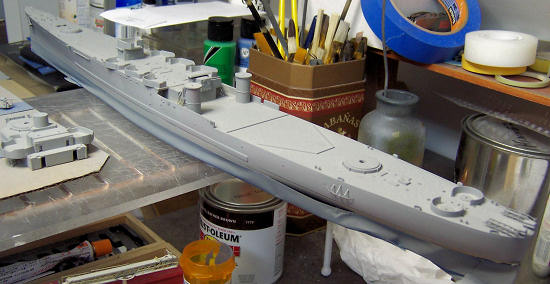 So to start, the lower hull has to go first-
I cannot imagine attaching the hull as the last step as the directions
indicate.
After that was cleaned up and dry, I attached the 2 deck pieces.
I lose the moving turret feature but to me, having a solid hull to
work with is better.
I set the hull aside for now.
So to start, the lower hull has to go first-
I cannot imagine attaching the hull as the last step as the directions
indicate.
After that was cleaned up and dry, I attached the 2 deck pieces.
I lose the moving turret feature but to me, having a solid hull to
work with is better.
I set the hull aside for now.
I then proceed to build modules and set them aside as well:
1.
Main gun turrets
2.
Bridge deck levels-
I do not put them all together because I need to get in there to touch
up the deck blueÖPE ladders added where I can.
Many are left off until after painting.
3.
Searchlight platform-
replaced with very easy to fold
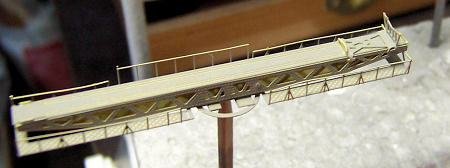 4.
PE catapults
4.
PE catapults
5.
PE cranes and pulleys
6.
7.
Catapult columns
8.
Secondary armament-
with some PE additions
All these sub-assemblies are stuck on a piece of cardboard
with double sided tape.
Then I prime all pieces with el cheapo Walmart light grey primer.
All the smaller pieces are left aside to be added later: 20 mm, boats, winches, reels, ready use ammo lockers, etc.
| COLORS & MARKINGS |
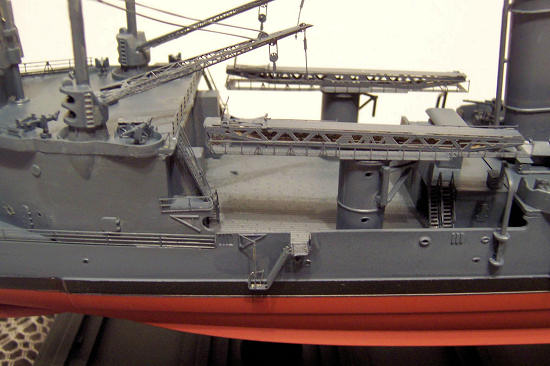 I have been a fan of the Model Master Acrylic Marine line-
you have to get them direct from Testorís website-
but they work great.
I just use regular water to thin them down.
This fit calls for the Navy Blue system:
Navy Blue 5-N on all vertical surfaces and Deck blue 20-B on all
horizontal decks.
It looks boring but I will try to drybrush some life into it later on.
I have been a fan of the Model Master Acrylic Marine line-
you have to get them direct from Testorís website-
but they work great.
I just use regular water to thin them down.
This fit calls for the Navy Blue system:
Navy Blue 5-N on all vertical surfaces and Deck blue 20-B on all
horizontal decks.
It looks boring but I will try to drybrush some life into it later on.
After the main hull was all painted, I mounted to an old
Trumpeter base with wooden thingies from craft store.
I drilled up through the base and the wood and went right into the
hull. It
allows you to move the model around without touching it while completing the
build.
Note:
I primed all the PE and then airbrushed Navy Blue-
but no matter what, flaking off occurs so I have to go back over all
the PE and touch up with a brush after it is installed.
After all painting was done on the sub-assemblies, they were added to the model in stages. Then the various PE railings and ladders were installed.
Last step was to drybrush. I used a medium grey and went over pretty much the whole ship. I tried to focus on edges and other protruding objects. This is a skill I have a lot to learn. In some areas, when I did it right, it does have a very nice effect and you can easily see the detail pop out. I certainly makes the monotone color look a bit better.
| CONCLUSIONS |
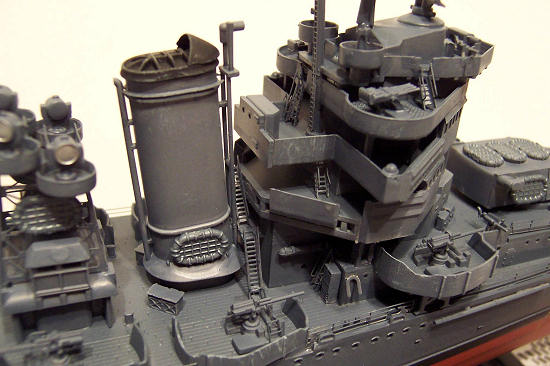 I just have a few things
left to add:
boats, the spotter plane and rigging.
I just have a few things
left to add:
boats, the spotter plane and rigging.
RIGGING:
I am leaving it alone for now-
There is a lot of rigging to do on this model and I do not want to
screw it up now.
So can anyone give me a good recommendation on what to use?
Since the length between masts is very long, I do not think stretching
sprue is an option-
it will sag to much.
So what is a good material to use and where can I get it?
The kit fit well, is a
very good size for 1/350 and with the always superb Gold Medal Models
photo-etched brass set, it turns into a very nice display.
As usual, the PE is tricky in some parts and very delicate but it sure
adds a lot to the look of the model.
The monotone scheme is a little boring but remember that the model
represents the ship during the
| REFERENCE |
http://www.usssanfrancisco.org/
July 2008
If you would like your product reviewed fairly and quickly, please contact me or see other details in the Note to Contributors.